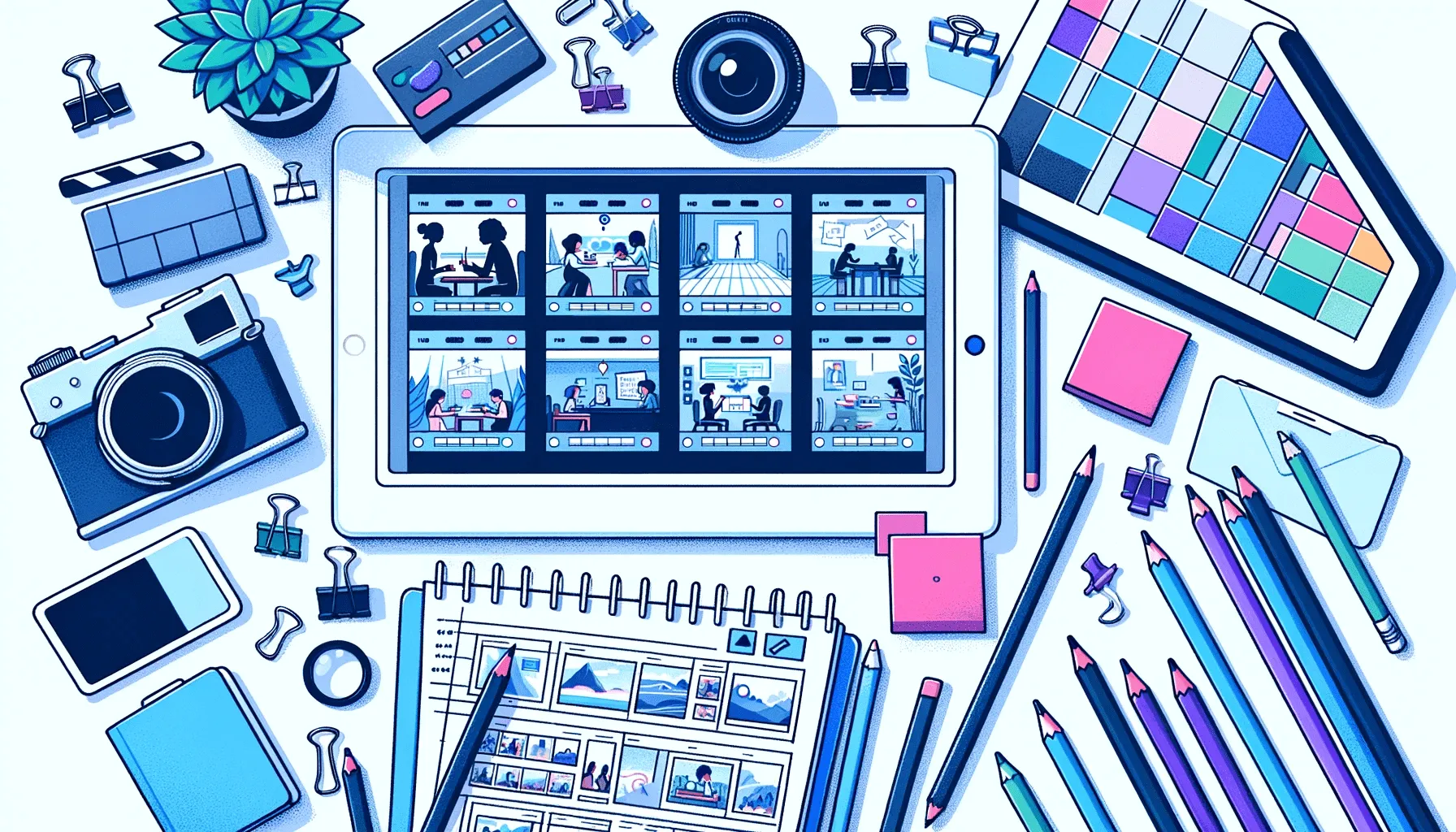

Turn your texts, PPTs, PDFs or URLs to video - in minutes.

“Drawing is the root of everything, and the time spent on that is actually all profit,” said Vincent Van Gogh.
Not everyone’s trying to make a masterpiece, but a little drawing can help you produce one kickass video.
Before making a video, it’s always a great idea to plan it out. When words fail, a storyboard succeeds because it creates visual clarity AND reduces the chances of someone misinterpreting your vision.
Storyboarding also prevents time-consuming, expensive production errors, so drawing a storyboard is always net profit.
This post covers the basics of storyboarding, when to use it, and how to quickly make one for your video.
What is a video storyboard, and why should you create one?
A storyboard is your visual script. It’s the sum of all the scenes that will show up in the video, arranged in chronological order as panels or frames. And it shows the narrative from the beginning until the end, reflecting the key scenes, shots, actions, camera angles, character movements, and other elements.
Storyboarding isn’t mandatory with all videos, but the more complex the project, the more you should consider it. If you’re working on explainer videos, commercials, animated videos, instructional or educational videos, VR or AR videos, having a storyboard before you begin shooting will help you to:
- Better visualize the complex story.
- Get different perspectives on what might work best for each shot idea.
- Refine the narrative of what you’ll put in front of the camera.
- Collaborate and communicate with everyone involved in making the video.
- Save time and resources by only shooting what serves your video intention.
Do you need to storyboard your video?
The simpler your video project is, the less you’ll worry about creating pre-production video storyboards.
You can skip video storyboarding when working on:
- Low-budget or time-constrained projects.
- Straightforward videos, like screen shares and quick software tutorials.
- Improvisational videos that capture spontaneous moments, like testimonials.
Here are some time-saving alternatives to video storyboarding:
- Shot list: A written list with shot description, camera angle, camera movement, and other relevant details for each shot.
- Script breakdown: A script analysis broken down into components like locations, characters, props, and actions.
- Mood board: Collages or images, colors, and other visual elements that represent how you want your video to look and feel.
- Shot planning discussion: Verbal brainstorming with the director, editor, and key crew members regarding the shots, camera angles, and visual approach.
- Ad hoc sketches or diagrams: Visuals drawn on the spot, only for shots or visual sequences that require clarification.
Visual storyteller and creative strategist Arielle Ray ties storyboarding into how much time you have at hand. Speaking from the experience of doing daily turnaround news videos at The Wall Street Journal, she says, “I almost always skip that step unless I have, like, at least three days to work at something.”
Option #1: Use an AI-powered all-in-one video editing tool
An AI-powered all-in-one video editor, such as Synthesia, helps you storyboard and create your video simultaneously. The editor generates your visuals based on a ChatGPT-like prompt and uses them to fill in a professionally designed video template. Once you’re happy with your storyboard, you hit the ‘Generate’ button, and the tool makes a video.
How to storyboard a video with an AI-powered video editing tool
Synthesia is an AI-powered video editor you can use to streamline video creation. You can use it to pair your script/dialogue with one of its 60+ professionally designed video templates that act as video storyboards and are fully customizable.
Or you can let it do all the work for you, scriptwriting and storyboarding, with AI-assisted scriptwriting. Just fill in some info, and it generates a script broken down line by line into video scenes based on a pre-designed template.
Apart from the AI scriptwriting and video storyboard templates, Synthesia hosts many other storyboarding-friendly features, such as 140+ diverse AI presenters, a generous media library with thousands of stock photos and videos, media upload support, and built-in screen recording.
Storyboarding in an AI video editor, step-by-step:
Step 1. Access your chosen video editor.
Step 2. Select a template from the editor’s built-in video templates library to customize it.
Step 3. Import footage and media assets by using the editor’s upload feature. Upload all the visuals you have at hand and plan on including them in your storyboard.
Step 4. Use the editor’s features to customize each shot and fill in the placeholders of the video storyboard template you selected with your desired visuals. Duplicate or delete a particular scene as you need, and change the order in which you want it to appear in your storyboard.
Step 5. Add annotations to guide the people reviewing your storyboard — comments about transitions, visual effects, timing, pacing, character actions, etc.
Step 6. Save your video storyboard and export it to share with the other team members. Depending on the editor’s functions, you might have to download the storyboard and send it through another channel, like email.
Option #2: Create a hand-drawn storyboard
This method involves manually sketching each shot or scene on paper or within a video storyboard template.
Artists and filmmakers often create storyboards in pencil or pen as rough drawings with sequences of shots, filming angles, character positions, and other essential visual elements. And it’s common practice to do it on a digital device such as a graphic tablet, an iPad with a pencil, or even in drawing software like Adobe Photoshop or Corel Painter.
Here’s an example of a hand-drawn storyboard:
 |
How to storyboard a video using the hand-drawn method:
Step 1. Whether you’ll draw on paper or using dedicated hand-drawing software or device, bring everything you need to your working table, along with the script that will guide you.
Step 2. Read and understand your script, and break it into scenes or sequences. Determine the number of shots or angles. Take notes of the appropriate composition for each scene to illustrate your video script.
Step 3. Visualize each scene’s key moments and elements, as well as the characters’ actions, expressions, and the environment they interact with. Draw by hand each scene considering different shot angles, even if you're doing rough sketches with stick figures.
Step 4. Sequence the shots to create a video flow. Consider how one scene leads to the next and how the overall rhythm of the video should unfold.
Step 5. Add captions, dialogue, and notes you think will help the production team.
Step 6. Review each scene to ensure it aligns with the script and narrative.
Option #3: Do a collage storyboard
Collaging is a quick method where you create a rough visual representation of the video by combining various mediums. For example, you could use hand-drawn elements, magazine cutouts, photos, or printed images to create a storyboard.
Collaging helps you assemble a representative storyboard that gives loose guidance and aims to convey the desired mood, setting, or atmosphere. You can do it on a physical board, putting pieces together, or on a digital tool or device. Consider graphic editing software like Adobe Photoshop, GIMP, Affinity Photo, or online collage makers like Canva, Pixlr, or BeFunky.
How to storyboard a video using the collage method:
Step 1. Read the script and determine the scenes you must illustrate in your storyboard.
Step 2. Depending on what you want to illustrate, cut images from printed media, use a photo editor to cut images from digital media, search for stock images of objects, or even take snapshots of physical products you own and want to include in the video.
Step 3. Upload all the visuals in a folder if you’re creating a digital collage, or put them on a large table if you’re creating a physical board.
Step 4. Group the images by scenes. Move them around until you get the right composition with the right combination of visuals to illustrate your narrative clearly.
Step 5. Because collage storyboards aren’t as detailed or accurate as other options, add more notes to guide the production team. Use notes on filming angles and movement, props and set design, audio effects, and transitions. For copyright compliance and proper attribution, write down the source of each visual you’ll use in the video.
Step 6. Ask for feedback from stakeholders and the filming team. Incorporate it in your revisions to make filming as easy as possible.
Option #4: Create a digital storyboard
This method is similar to storyboarding in an AI video editor but with heavy human input. Artists or filmmakers are typically involved in this process, and it’s the preferred storyboarding method for modern films and high-end TV ads.
You can create it using storyboarding software, apps, or specialized digital storyboard tools like Storyboarder, Storyboard That, Boords, FrameForge, or ToonBoom Storyboard Pro, and:
- Use readymade storyboard templates or stock images.
- Use built-in shot generators that create 2D/3D versions of your scenes and even set camera angles for you.
- Use digital drawing tools to draw some or all illustrations yourself.
Here’s an example of an artist illustrating a scene from a storyboard, drawing in a digital storyboard tool.
 |
How to storyboard a video using the digital method:
Step 1. Create a new video storyboard project in your chosen tool or graphic design software and set your desired dimensions.
Step 2. Break down your script into scenes and each scene into shots. Use the tools and templates provided by your chosen software to sketch or create each digital shot.
Step 3. Create the video flow by reviewing the order of all the shots and scenes in your digital storyboard.
Step 4. Use the editing options to include annotations, captions, or descriptions that can help the filming team and give the stakeholders who’ll review it more clarity.
Step 5. Save the storyboard and export it so the other decision-makers in the team can give you feedback.
Pick from 60+ pre-designed video templates and storyboard your video today
With the AI video creator Synthesia, you can video storyboard right in the tool by selecting a video template and customizing all its placeholders with your desired visuals.
Browse our collection of video templates to get a feel for what it’s like to storyboard a video with Synthesia.
About the author
Learning Strategist & Speaker
Elly Henriksen
Elly Henriksen is a accomplished instructional designer exploring the impact of AI-generated content on learning design.












